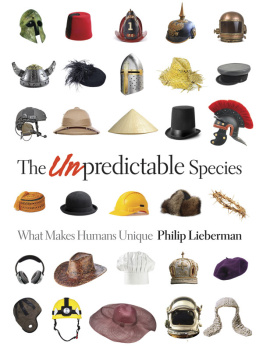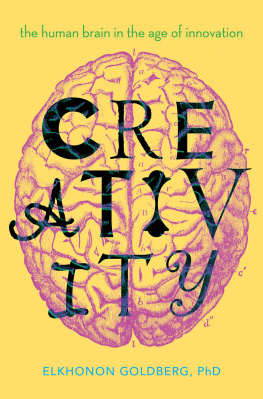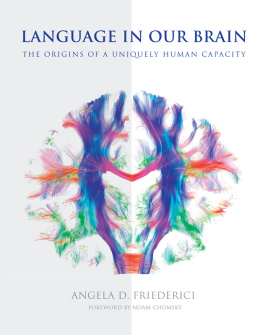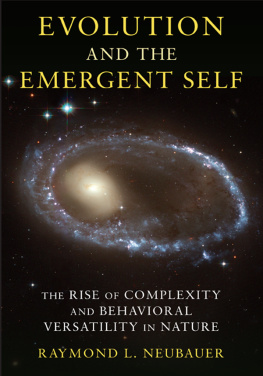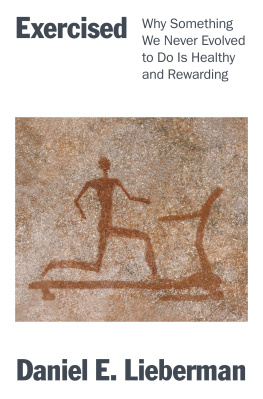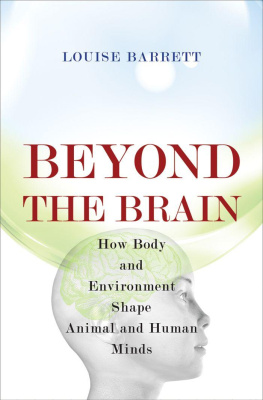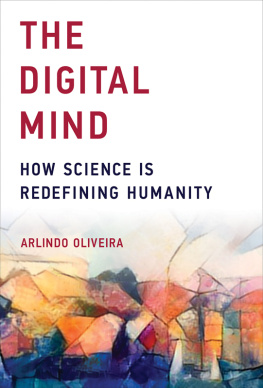
The Unpredictable Species
Philip Lieberman
The Un predictable Species
WHAT MAKES HUMANS UNIQUE
PRINCETON UNIVERSITY PRESS
Princeton and Oxford
Copyright 2013 by Princeton University Press
Published by Princeton University Press, 41 William Street,
Princeton, New Jersey 08540
In the United Kingdom: Princeton University Press, 6 Oxford Street,
Woodstock, Oxfordshire OX20 1TW
press.princeton.edu
All Rights Reserved
Library of Congress Cataloging-in-Publication Data
Lieberman, Philip.
The unpredictable species : what makes humans unique / Philip Lieberman.
pages cm
Includes bibliographical references and index.
ISBN 978-0-691-14858-8 (cloth : alk. paper) 1. BrainEvolution. 2. Human evolution. 3. Evolutionary psychology. I. Title.
QP376.L563 2013
612.82dc23 2012037744
British Library Cataloging-in-Publication Data is available
This book has been composed in Electra
Printed on acid-free paper.
Printed in the United States of America
10 9 8 7 6 5 4 3 2 1
To Marcia
Contents
Preface
S carcely a day passes without a report about genes associated with debilitating diseases such as early onset diabetes or breast cancer. Other genes allow you to happily eat ice cream and drink milk because Darwinian natural selection acted on your distant ancestors, allowing them to digest lactose beyond infancy. And you can hardly be unaware of the debate surrounding genetically modified organisms (GMOs) in the food chain or on the farm. Many of the genetic differences between humans and chimpanzees are now clear. Advances in genetic research are producing startling results. Trading on these developments, it isnt surprising that a simple explanation for the way that we humans act has been accepted in academic circles and by most everyone else. We supposedly have genes that confer language, make us moral or religious, favor our close relatives, allow us to detect cheats, determine our taste in art, and so on. Simple solutions to complex problems are always appealing.
The focus here will be on research that points to understanding how the human brain evolved so as to allow us to choose between alternative courses of action and to create new possibilitiesin short, the creative capacity that sets us aside from other species. Presently, no one can definitively tell you how the human brain works, but we can rule out the nineteenth-century models that guide the gene that controls something school of thoughtwhether it is language, math, morality, favoring relatives, and the like. Advances in neuroscience show that our brains do not operate in a manner similar to the components that make up digital computers. The biological brain doesnt consist of independent modulessubsystems that each control a specific function, one module operating the keyboard or touch screen, another devoted to the display, and so on. Instead, specific structures of the brain clearly carry out particular local operations, but these operations dont constitute an aspect of behavior that you can observe. The instructions for moving your arm forward, which involves a learning process carried out by a set of linked parts of the brain, are stored in the motor cortex, but even so seemingly simple a task as lifting a glass of water to your mouth involves pulling these instructions out of this motor memory store through local operations carried out in different parts of your brain, linked together in a circuit. I will describe some of these neural circuits and what they do, peeling away later in the text, the technical jargon.
Surprisingly, brain structures whose roots can be traced back to before the age of dinosaurs play a critical role in circuits involved in learning and executing motor acts, as well as in thinking. Neural circuits that first evolved for motor control were tweaked so that they regulate a range of linguistic and cognitive acts, including our creative ability to form new ways of acting and thinking, and choosing among them. Charles Darwin wasnt aware of DNA, nor was he aware of the mechanisms of genetic evolution, but ongoing studies show that the guiding principles of evolution that Darwin proposed account for why we are not hairless chimpanzees, even though almost 99 percent of our genes are similar. Instead, natural selection acting on genetic variation, and the opportunistic use of existing organs adapted for one function to another, accounts for the neural bases of human language and our not being ruled by genes fixed in human prehistory or in our animal forbears.
The story isnt overwere just at the starting point, but it is clear that determinist theories like those proposed by Noam Chomsky are untenable. As well see, attested evidence of Darwinian natural selection acting on humans and the presence of genetic variation rule out Chomskys views, as well as related theories that claim that we have moral genes, cheater-detector genes, or monogamy genes. Other living species show signs of creativity, and that certainly was the case for extinct hominins such as the Neanderthals, but cultural innovation fueled by the enhanced creative capacities of human brains has made us the unpredictable species. The result is that we are able to shape our actions and destiny for better or worse.
Philip Lieberman
Providence, Rhode Island
May 30, 2012
Acknowledgments
I must stress my debt to the work of hundreds of scientists over the course of more than a century. At a personal level, I owe much to my students and colleagues (the distinction has become very indistinct), who have continually pushed me to think harder about how we came to be and to carry out studies to test guesses (aka hypotheses). Terrance Nearey, and Robert Buhr were among the first. Molly Mack and Karen Landahl, whose untimely deaths have left a void, provided insights on how children and adults learn languages and the nature of speech and language, as did Judith Parker, Joan Sereno, Allard Jongman, and Patricia Kuhl. Joseph Friedman, Liane Feldman, Emily Pickett, Hiroko Nakano, Jesse Hochstadt, Beverly Young, Angie Morey, Sheila Blumstein, Jennifer Adeylott, Thanassi Protopapas, Sonja Kotz, John Donoghue, Ann Graybiel, and Oury Monchi helped me understand how brains seem to work. Alvin Liberman, Franklin Cooper, Edmund Crelin, Arend Bouhuys, Ken Stevens, Dennis Klatt, and Jeffrey Laitman played key roles in research on the role of speech in language and its evolution. Though I think that he has set a wrong course, Noam Chomsky initially set me on this journey. Tecumseh Fitch, before he signed onto Chomskys crew, made significant contributions on the evolution of human speech. Chu-Yu Tseng guided me through the tone languages that most people on earth speak. Liz Bates and Fred Dick helped in everything. My son Daniel Lieberman, with Robert McCarthy, showed that the time course for the development of the anatomy that allows humans to produce sounds that enhance speech communication extends over the first eight years of life, instead of a year. Daniels comprehensive study of the evolution of the human skull has been invaluable. My son Benjamins book, Terrible Fate: Ethnic Cleansing in the Making of Modern Europe, forcefully pointed out facts that cast doubt on any genetic basis for moral conduct. Robert McCarthys studies of the fossil record of human evolution were especially helpful. Svante Paabo graciously shared his thoughts on the transcriptional factor, FOXP2, that distinguishes us from other species. Eric Schwartz at Princeton University Press provided sagacious editorial advice throughout this project. And Marcia Lieberman put up with my continually intruding on her own work to see what she thought of what I was thinking of at the moment. But any misinterpretations of anyones research or ideas are my own.
Next page
